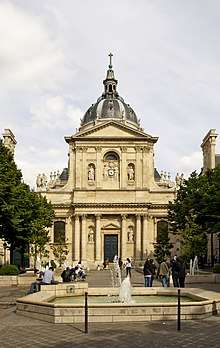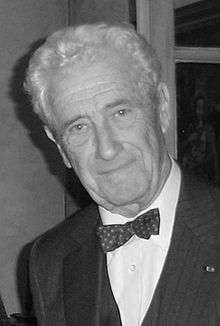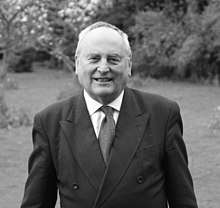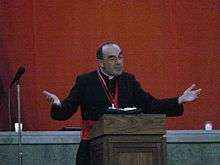Paris-Sorbonne University
Paris-Sorbonne University (also known as Paris IV; French: Université Paris-Sorbonne, Paris IV) was a public research university in Paris, France, active from 1971 to 2017. It was the main inheritor of the Faculty of Humanities of the University of Paris. In 2018, it was merged with Pierre and Marie Curie University and some smaller entities to form a new university called Sorbonne University.
Université Paris-Sorbonne (Paris IV) | |
 Logo of Paris-Sorbonne University | |
| Type | Public |
|---|---|
| Active | 1 January 1971–31 December 2017 |
| Budget | €118,800,000[1] |
| President | Barthélémy Jobert |
Academic staff | 1,300 |
Administrative staff | 774 |
| Students | 23,505 |
| Undergraduates | 13,900 |
| Postgraduates | 6,916 |
| 2,508 | |
| Location | Paris , France 48°50′55″N 2°20′34″E |
| Campus | 12 urban campuses |
| Newspaper | Presses de l'Université Paris-Sorbonne |
| Colours | Indigo, Gold |
| Athletics | Association Sportive de Paris IV |
| Nickname | Paris IV |
| Affiliations | Sorbonne University group |
 France Paris | |
Paris-Sorbonne University was consistently ranked as France's as well as one of the world's most prominent ones in the humanities. QS World University Rankings ranked it 13th in humanities internationally in 2010, and 17th in 2011 and 2012.[2] Times Higher Education World University Rankings also ranked it as France's highest reputed institution of higher education overall in 2012.[3]
History

Paris-Sorbonne University was one of the inheritors of the Faculty of Humanities (French: Faculté des lettres) of the University of Paris[1] (also known as the Sorbonne), which ceased to exist following student protests in May 1968. The Faculty of Humanities of was the main focus of the University of Paris, and subsequently Paris-Sorbonne University was one of its main successors.[4] It was a member of the Sorbonne University Group.
Paris-Sorbonne University enrolled about 24,000 students in 20 departments specialising in arts, humanities and languages, divided in 12 campuses throughout Paris. Seven of the campuses were situated in the historic Latin Quarter, including the historic Sorbonne university building, and three in the Marais, Malesherbes and Clignancourt respectively. In addition, the university also maintained one campus in Abu Dhabi, United Arab Emirates, alter called Sorbonne University Abu Dhabi. Paris-Sorbonne University also comprised France's prestigious communication and journalism school, CELSA, located in the Parisian suburb of Neuilly-sur-Seine. Paris-Sorbonne University maintained about 400 international agreements.
As a successor of the faculty of humanities of the University of Paris, it was a founding member the Sorbonne University group, an alliance with the successor of the faculty of law and economics and of the faculty of science of the University of Paris; Panthéon-Assas University and Pierre-and-Marie-Curie University.[5] This group allowed Paris-Sorbonne University students to study several dual degrees in combinations. Two graduate certificates in law from Panthéon-Assas University (Sorbonne Law School) were accessible for all the student members of the Sorbonne University group.[6]
Succession: Sorbonne University
Paris-Sorbonne University merged with Pierre-and-Marie-Curie University into the Sorbonne University, effective from 1 January 2018.[7][5]
Notable people
Notable faculty and staff

Notable Paris-Sorbonne university faculty include:
- Dominique Barbéris, novelist, French literature
- Yves-Marie Bercé, historian, member of the Académie des sciences morales et politiques (2007)
- Philippe Contamine, historian, member of the Académie des inscriptions et belles-lettres
- Denis Crouzet, historian, awarded the Madeleine Laurain-Portemer prize by the Académie des Sciences Morales et Politiques
- Marc Fumaroli, member of the Académie française, professor at the Collège de France
- Jean Favier (1932-2014), historian, member of the Académie des Inscriptions et Belles-Lettres
- Nicolas Grimal, egyptologist, member of the Académie des Inscriptions et Belles-Lettres
- Claude Lecouteux, historian
- Jean-Luc Marion, philosopher, member of the Académie française (2008)
- Danièle Pistone, musicologist, correspondent member at the Académie des beaux-arts (2014)
- Frédéric Regard, littérature britannique, spécialiste des études de genre en France
- Jean-Yves Tadié, English Literature
- Jean Tulard, historian, member of the Académie des sciences morales et politiques (1994)
Notable alumni


- Donald Adamson (born 1939), British historian
- Shmuel Agmon (born 1922), Israeli mathematician
- Hamad Bin Abdulaziz Al-Kawari (born 1948), Qatari diplomat
- Sophia Antoniadis (1895-1972), classical scholar and first female professor at Leiden University
- Philippe Barbarin (born 1950), French Catholic Archbishop of Lyon and cardinal
- Charlotte Casiraghi (born 1986), Italian fashion journalist
- Karl P. Cohen (1913–2012), American physical chemist
- Ioan Petru Culianu (1950–1991), Romanian historian
- Mamadou Diouf, Senegalese professor of Western African history at Columbia University
- Elsa Dorlin, philosopher and feminist
- Marie Drucker (born 1974), French journalist
- Soudabeh Fazaeli (born 1947), Iranian seismologist, researcher, mythologist and writer
- Luc Ferry (born 1951), French philosopher
- Henri Guaino (born 1957) French politician
- William Irigoyen (born 1970), French journalist
- Besiana Kadare (born 1972), Albanian Ambassador to the UN
- Samir Kassir (1960–2005), Lebanese-French professor of history at Saint-Joseph University
- Jiddu Krishnamurti (born 1895), Indian philosopher
- Caterina Magni (born 1966) Italian-French archaeologist
- Shahrzad Rafati (born 1980), Iranian-Canadian media entrepreneur
- Bernard Romain (born 1944), French painter and sculptor
- Christiane Taubira (born 1952), Minister of Justice of France
- Habib Tawa (born 1945), Lebanese-French historian
- Jean-Pierre Thiollet (born 1956), French writer
- Shunichi Yamaguchi (born 1950), Japanese politician
- Nureldin Satti, Sudanese diplomat and ambassador to the United States.[8]
- Jemima West (born 1987), Anglo-French actress
See also
- Sorbonne University, its successor
- University of Paris, its predecessor
- Sorbonne
- Education in France
References
- "Rapport d'évaluation de l'Université Paris-Sorbonne — Paris IV" (PDF). Agence d'évaluation de la recherche et de l'enseignement supérieur. November 2009. p. 7. Archived from the original (PDF) on 28 March 2012. Retrieved 22 July 2011.
- "Université Paris-Sorbonne (Paris IV) Rankings". Top Universities. Retrieved 19 December 2019.
- "World Reputation Rankings 2012 | Times Higher Education (THE)". Times Higher Education. Retrieved 19 December 2019.
- "Paris-Sorbonne, L'historique". Archived from the original on 6 April 2015. Retrieved 30 August 2017.
- University World News, Merger of elite Paris universities gets the go-ahead
- Les échos - Un bagage en droit de plus en plus utile
- Le Figaro, Le retour de la grande université de Paris
- "Ambassador Dr. Nureldin Satti – Yintab Strategy Consults". Retrieved 5 May 2020.